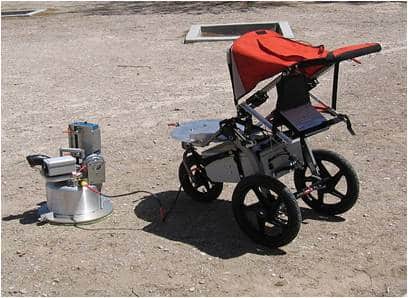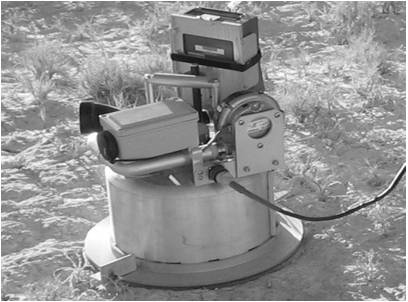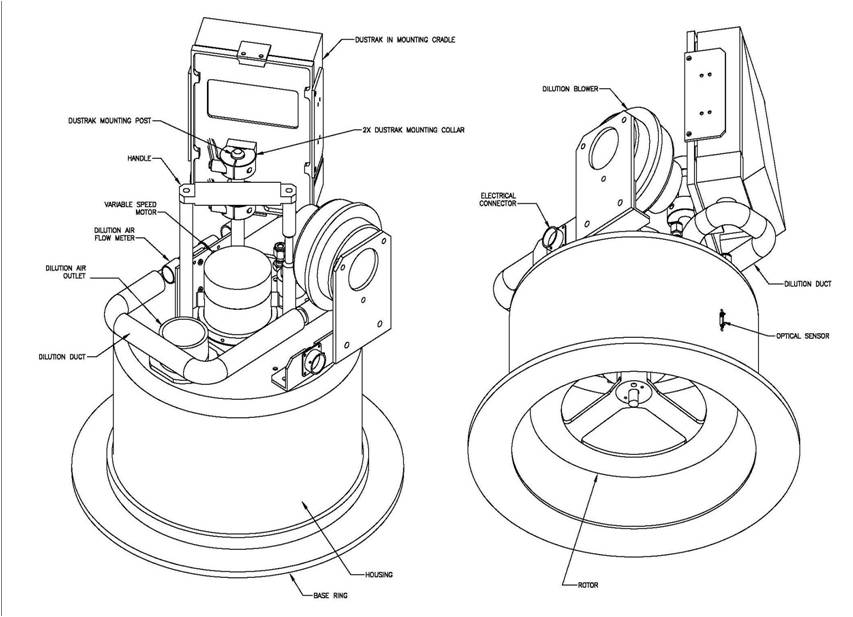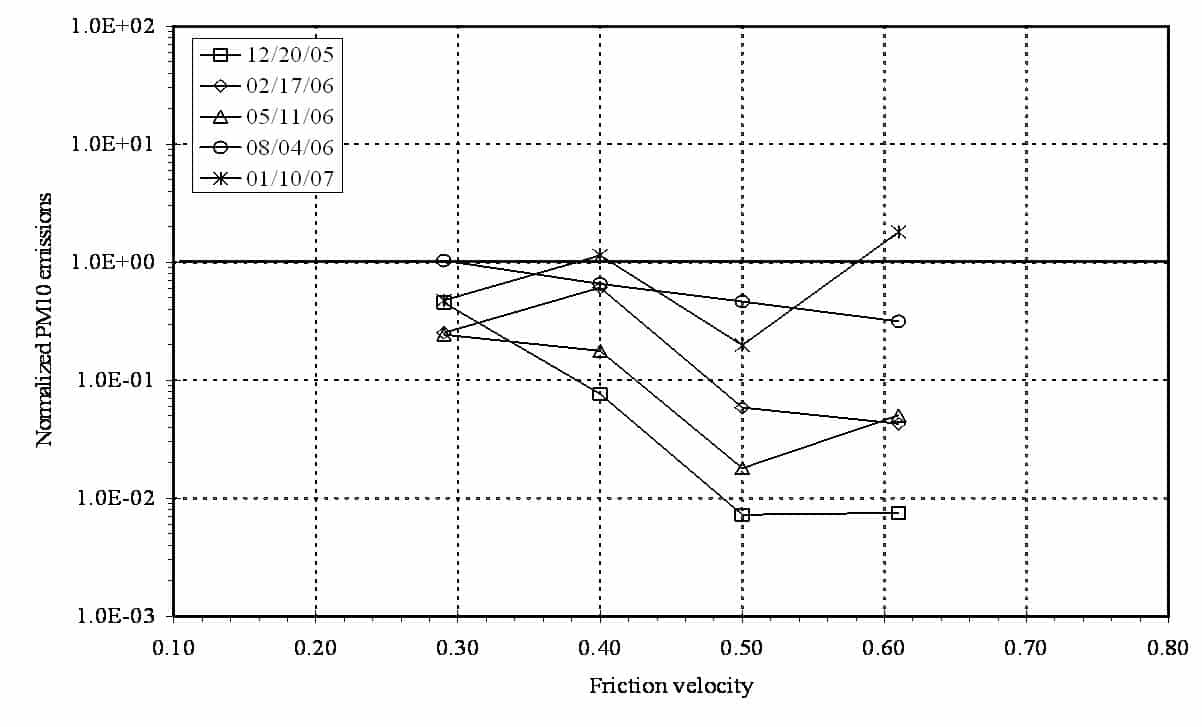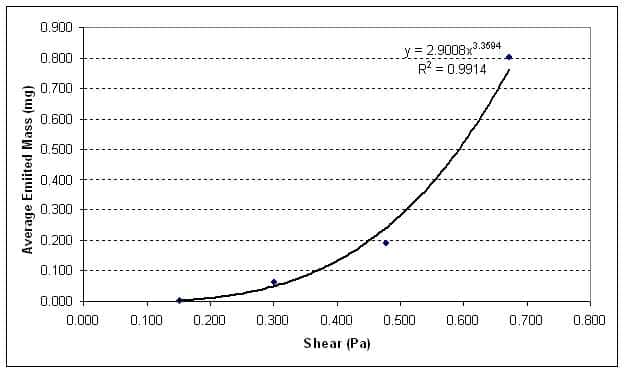Portable In-Situ Wind ERosion Lab: PI-SWERL
The PI-SWERL, which stands for Portable In-Situ Wind ERosion Lab, has been in development at DRI since 2000. The PI-SWERL concept was motivated by the need for a portable device to test and measure the potential for wind erosion and dust emissions from real-world surfaces. Traditional wind tunnels used for this purpose required long setup times and in some cases a crew of several people to operate. The goal in developing the PI-SWERL was to provide a turn-key device that was easy to move, required minimal setup, and could be operated by one person. A prototype developed in 2000 and tested alongside the University of Guelph large, field wind tunnel provided early indication of the feasibility of the PI-SWERL concept. Since then several models have been used in numerous field investigations. The latest miniature version (MPS-2a) has been a workhorse instrument for DRI since 2005 and its design has remained essentially constant. In 2007, DRI licensed the PI-SWERL technology to Dust-Quant LLC to make it commercially available to users worldwide.
The PI-SWERL is contained in an open-bottomed, cylindrical chamber operated by a direct-current motor that spins a metal, annular ring about 2.5 in. above and parallel to the soil surface. Principles of fluid mechanics allow simulation of high winds that produce dust storms. The spinning ring creates known wind shear, lofting soil and dust particles and passing them through particulate monitors. The PI-SWERL electronically measures the number and size of entrained particles over the duration of a test cycle, typically under 10 minutes. By controlling the speed of the ring to simulate varying wind speeds, the potential for a soil surface to produce PM10 dust emissions can be determined under a range of simulated wind conditions.
PI-SWERL allows for elucidation of effects of specific road characteristics with respect to dust emissions. It can be used to assess the effect of pavement properties on dust emissions, potential for windblown dust on unpaved roads, effectiveness of surface treatments on reducing emissions, emissions from road shoulders, and potential for aerodynamically driven emissions for vehicles traveling at different speeds.
The PI-SWERL (US Patent 7,155,966) measures the amount of dust emitted from a surface when a known amount of wind shear is applied. A flat annular blade inside the chamber rotates at prescribed speeds to simulate different amounts of surface shear stress. Although it uses a different principle of operation, it can be thought of as analogous to a miniature wind tunnel.
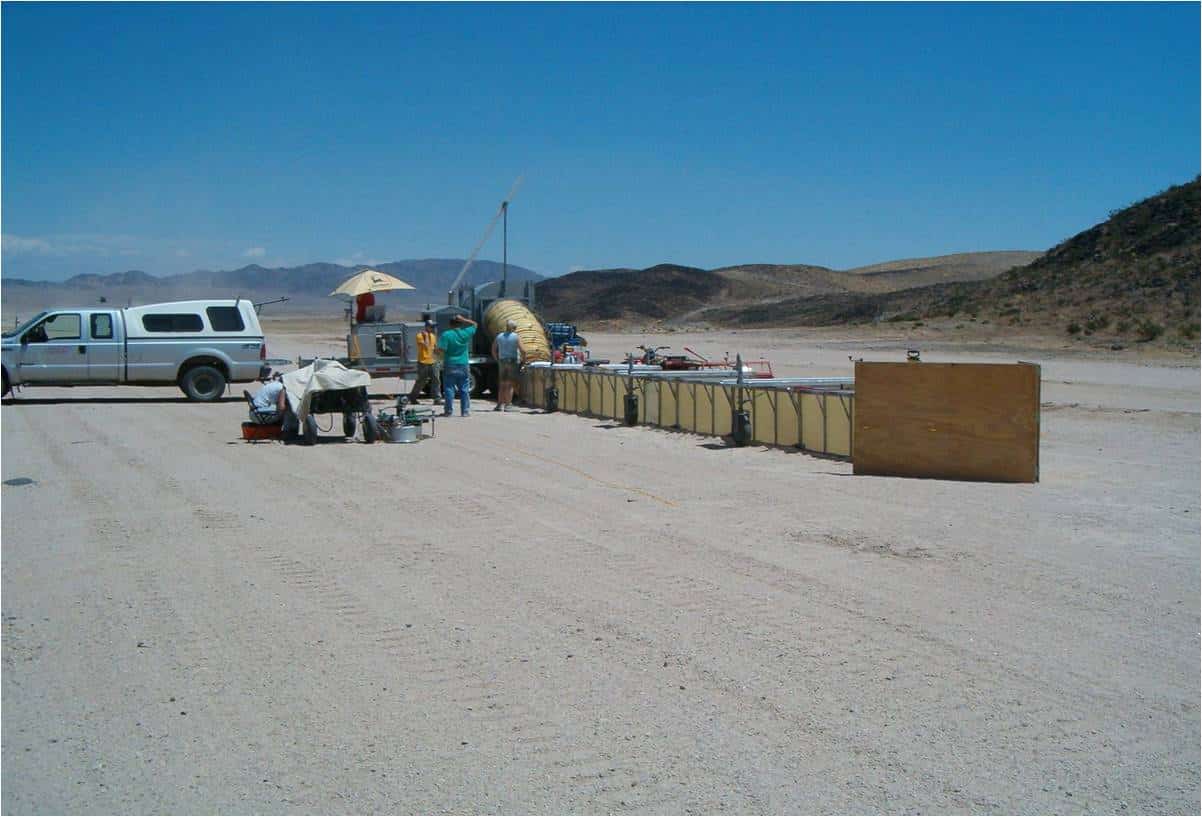
PI-SWERL and Wind Tunnel Simulations
The PI-SWERL was collocated with the University of Guelph large field wind tunnel at seventeen sites in the Mojave desert, spanning graveled roads to silty playas (Sweeney, et. al., 2008). Agreement between the two methods of estimating dust emissions was good with a correlation coefficient of 0.76 and a nearly 1:1 slope.
-

PI-SWERL data: PM10 dust emissions from a chemically treated test plot (right photo) normalized to dust emissions from a test plot that has not been treated (left) over 1 year exposure (Kavouras, et. al., 2007). X-axis: friction velocity (m/s) – a measure of surface wind shear.
-

PI-SWERL data: rapid non-linear increase in PM10 emissions with increase in aerodynamic shear (Pascals, N/m2, proportional to wind speed or tire stress) applied to paved road surface (China, 2008), indicating value of keeping speed limits low.
Bacon, S. N., E. V. McDonald, et al. “Total suspended particulate matter emissions at high friction velocities from desert landforms.” Journal of Geophysical Research-Earth Surface 116.
Buck, B. J., J. King, et al. “Effects of Salt Mineralogy on Dust Emissions, Salton Sea, California.” Soil Science Society of America Journal 75(5): 1971-1985.
Etyemezian, V., G. Nikolich, et al. (2007). “The Portable In Situ Wind Erosion Laboratory (PI-SWERL): A new method to measure PM(10) potential for windblown dust properties and emissions.” Atmospheric Environment 41(18): 3789-3796.
Goossens, D. and B. Buck (2009). “Dust dynamics in off-road vehicle trails: Measurements on 16 arid soil types, Nevada, USA.” Journal of Environmental Management 90(11): 3458-3469.
Kavouras, I. G., V. Etyemezian, et al. (2009). “A New Technique for Characterizing the Efficacy of Fugitive Dust Suppressants.” Journal of the Air & Waste Management Association 59(5): 603-612.
King, J., V. Etyemezian, et al. “Dust emission variability at the Salton Sea, California, USA.” Aeolian Research 3(1): 67-79.
Sankey, J. B., J. U. H. Eitel, et al. “Quantifying relationships of burning, roughness, and potential dust emission with laser altimetry of soil surfaces at submeter scales.” Geomorphology 135(1-2): 181-190.
Sweeney, M., V. Etyemezian, et al. (2008). “Comparison of PI-SWERL with dust emission measurements from a straight-line field wind tunnel.” Journal of Geophysical Research-Earth Surface 113(F1).
Sweeney, M. R., E. V. McDonald, et al. “Quantifying dust emissions from desert landforms, eastern Mojave Desert, USA.” Geomorphology 135(1-2): 21-34.
Particulate Emissions Measurement Laboratory Publications from 2003-2008
2008
Macpherson, T., W.G. Nickling, J.A. Gillies, and V. Etyemezian (2008). Dust emissions from undisturbed and disturbed supply limited desert surfaces. J. Geophys. Res., Earth Surface (in press).
Brown, S. W.G. Nickling, and J.A. Gillies (2008). A wind tunnel examination of shear stress partitioning for an assortment of surface roughness distributions. J. Geophys. Res., Earth Surface, 113, doi:10.1029/2007JF000790.
King, J., W.G. Nickling, and J.A. Gillies (2008). Investigations the law-of-the-wall over sparse roughness elements. J. Geophys. Res., Earth-Surface, 113, F02S07, doi:10.1029/2007JF000804.
Sweeney, M., V. Etyemezian, T. Macpherson, W. Nickling, J. Gillies, G. Nikolich, and E. McDonald (2008). Comparison of PI-SWERL with dust emission measurements from a straight-line field wind tunnel. J. Geophys. Res., Earth Surface, 113, F01012, doi:10.1029/2007JF000830.
2007
Gillies, J.A., V. Etyemezian, H. Kuhns, J. Engelbrecht, S. Uppapalli, and G. Nikolich (2007). Dust emissions caused by backblast from Department of Defense artillery testing. J. Air & Waste Manage. Assoc., 57, doi:10.3155/1047-3289.57.5.551, 551–560.
Etyemezian, V., G. Nikolich, S. Ahonen, M. Pitchford, M. Sweeney, J. Gillies, and H. Kuhns (2007). The Portable In-Situ Wind Erosion Laboratory (PI-SWERL): a new method to measure PM10 windblown dust properties and potential for emissions. Atmos. Environ., 41, 3789-3796.
Gillies, J.A., W.G. Nickling, and J. King (2007). Shear stress partitioning in large patches of roughness in the atmospheric inertial sublayer. Boundary-Layer Meteorology, 122(2), doi: 10.1007/s10546-006-9101-5, 367-396.
2006
Gertler, A., H. Kuhns, M. Abu-Allaban, C. Damm, J. Gillies, V. Etyemezian, R. Clayton, and D. Proffitt (2006). A case study of the impact of winter road sand/salt and street sweeping on road dust re-entrainment. Atmos. Environ., 40(31):5976-5985.
King, J., W.G. Nickling, and J.A. Gillies (2006). Aeolian shear stress ratio measurements within mesquite-dominated landscapes of the Chihuahuan Desert, New Mexico, USA. Geomorphology, 82(3-4):doi:10.1016/j.geomorph.2006.05.004, 229-244.
Gillies, J.A., W.G. Nickling, and J. King (2006). Aeolian sediment transport through large patches of roughness in the atmospheric inertial sublayer. J. Geophys. Res., Earth Surface, 111, F02006, doi:10.1029/2005JF000434.
2005
King, J., W.G. Nickling, and J.A. Gillies (2005). Representation of vegetation and other non-erodible elements in aeolian shear stress partitioning models for predicting transport threshold. J. Geophys. Res., Earth Surface, 110 (F4):F04015 doi:10.1029/2004JF000281.
Moosmüller, H., R. Varma, W.P. Arnott, H.D. Kuhns, V. Etyemezian, and J.A. Gillies (2005). Scattering cross section emission factors for visibility and radiative transfer applications: military vehicles traveling on unpaved roads. J. Air and Waste Manage. Assoc., 55:1743-1750.
Gillies, J.A., V. Etyemezian, H. Kuhns, D. Nickolic, and D.A. Gillette (2005). Effect of vehicle characteristics on unpaved road dust emissions. Atmos. Environ., 39:2341-2347.
Kuhns, H., V. Etyemezian, J.A. Gillies, S. Ahonen, C. Durham, and D. Nikolic (2005). Spatial variability of unpaved road dust emissions factors near El Paso, Texas. J. Air and Waste Manage. Assoc., 55:3-12.
2004
Etyemezian, V., J.A. Gillies, H. Kuhns, D. Gillette, S. Ahonen, D. Nikolic, and J. Veranth (2004). Deposition and removal of fugitive dust in the arid southwestern United States : measurements and model results. J. Air and Waste Manage. Assoc., 54:1099-1111.
2003
Etyemezian, V., H. Kuhns, J.A. Gillies, M. Green, M. Pitchford, and J. Watson (2003). Vehicle based road dust emissions measurement (I): methods and calibration. Atmos. Environ., 37:4559-4571.
Etyemezian, V., H. Kuhns, J.A. Gillies, J. Chow, M. Green, K. Hendrickson, M. McGowan, and M. Pitchford (2003). Vehicle based road dust emissions measurement (III): effect of speed, traffic volume, location, and season on PM10 road dust emissions. Atmos. Environ., 37:4583-4593.
Abu-Allaban, M., J.A. Gillies, and A.W. Gertler (2003). Applications of a multi-lag regression approach to determine on-road PM10 and PM2.5 emission rates. Atmos. Environ., 37:5157-5164.
Abu-Allaban, M., J.A. Gillies, and A.W. Gertler (2003). Tailpipe, resuspended road dust, and brake-wear emission factors from on-road vehicles. Atmos. Environ., 37:5283-5293.
CONTACT
George Nikolich
702.862.5413
George.Nikolich@www-dev.dri.edu
Vic Etyemezian, Ph.D.
702.862.5569
Vic.Etyemezian@www-dev.dri.edu
LOCATION
Desert Research Institute
755 East Flamingo Road
Las Vegas, NV 89119
DIVISION
Atmospheric Sciences
